Imagine transforming your small 10×5-foot balcony into a luxurious flower haven with high-end ceramic planters in glossy black. You can create a stunning display by choosing the right elements and techniques. Start with selecting premium containers; they set the tone for elegance. Curious about the other nine ways to elevate your space? Stick around to uncover practical steps for a breathtaking balcony oasis.

Contents
- 1 Choose High-End Planters for a Polished Look
- 2 Layer Plants for Depth and Dimension
- 3 Opt for Vibrant Color Schemes
- 4 Incorporate Trailing Vines for Drama
- 5 Mix Textures With Foliage and Blooms
- 6 Add Vertical Gardens for Space Efficiency
- 7 Use Statement Flowers as Focal Points
- 8 Integrate Ambient Lighting for Evening Charm
- 9 Select Seasonal Varieties for Year-Round Beauty
- 10 Create Symmetry for a Balanced Design
Choose High-End Planters for a Polished Look
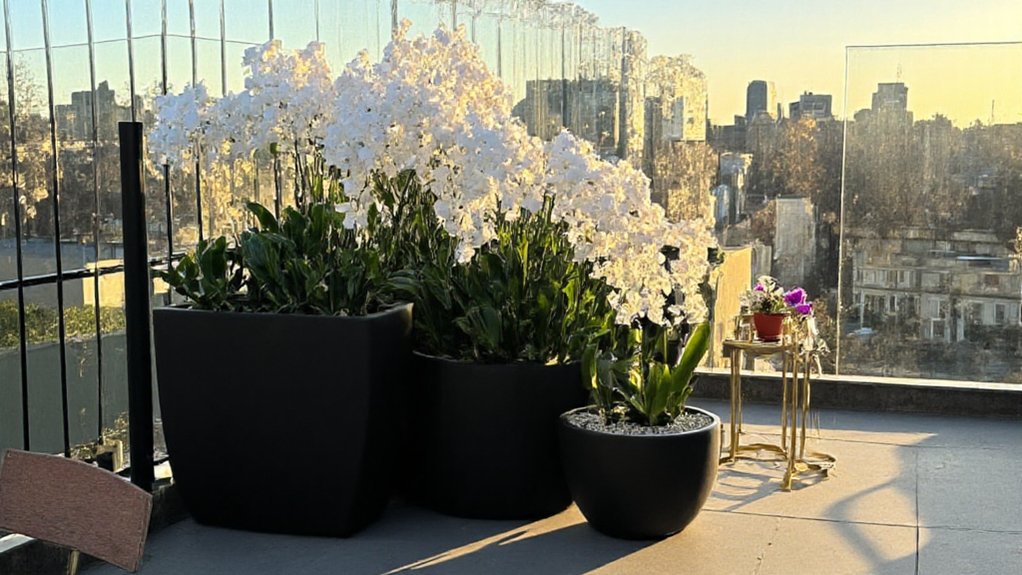
Choosing high-end planters for your balcony flower displays can greatly elevate the overall aesthetic of your outdoor space. Opt for materials like ceramic, glazed terracotta, or sleek metal finishes that exude sophistication and durability. These premium planters not only serve as functional containers for your plants but also act as stylish decor elements that complement your balcony’s design.
Additionally, high-end planters often come in unique shapes, textures, and colors, allowing you to create a cohesive and polished look. Investing in quality planters guarantees they withstand weather conditions while maintaining their elegance, making them a worthwhile addition to your balcony garden.
Layer Plants for Depth and Dimension

Layering plants in a balcony flower display is a key technique to create depth and dimension, transforming a flat space into a visually enchanting arrangement. By strategically placing taller plants at the back or center and shorter ones in the front or along the edges, you can mimic the natural look of a garden bed, drawing the eye through different levels and adding a sense of fullness to the display.
To achieve this effect, start with taller structural plants like ornamental grasses, small shrubs, or climbing vines on trellises as a backdrop. Then, add medium-height plants such as geraniums or petunias in the middle layer, and finish with trailing or low-growing varieties like ivy, lobelia, or sweet alyssum at the front to spill over the edges. This tiered approach not only maximizes space on a small balcony but also guarantees each plant is visible and contributes to a lush, dynamic look.
Opt for Vibrant Color Schemes
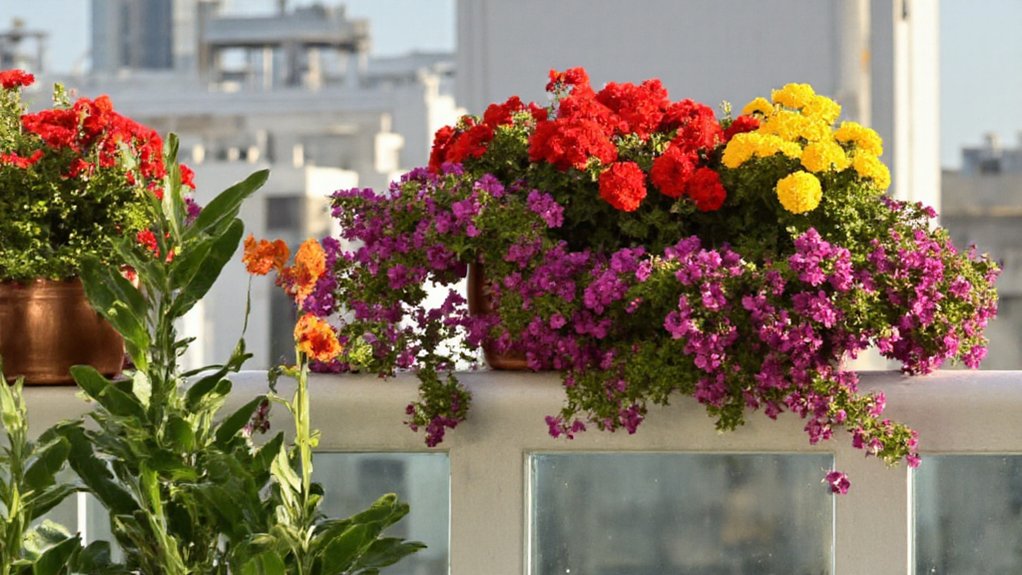
When designing balcony flower displays, opting for vibrant color schemes can transform your outdoor space into a lively and inviting area. Bright colors like reds, yellows, and oranges can create a warm and energetic atmosphere, while bold purples and blues add a touch of drama and depth. Choosing flowers with striking hues, such as marigolds, petunias, or geraniums, can make your balcony a focal point, drawing the eye and uplifting the mood of the space.
To maximize the impact, consider combining complementary colors or creating a monochromatic scheme with varying shades of the same color for a cohesive look. Vibrant color schemes not only enhance the visual appeal of your balcony but also attract pollinators like bees and butterflies, adding life and movement to your display. Experiment with seasonal blooms to keep the colors fresh and dynamic throughout the year.
Incorporate Trailing Vines for Drama
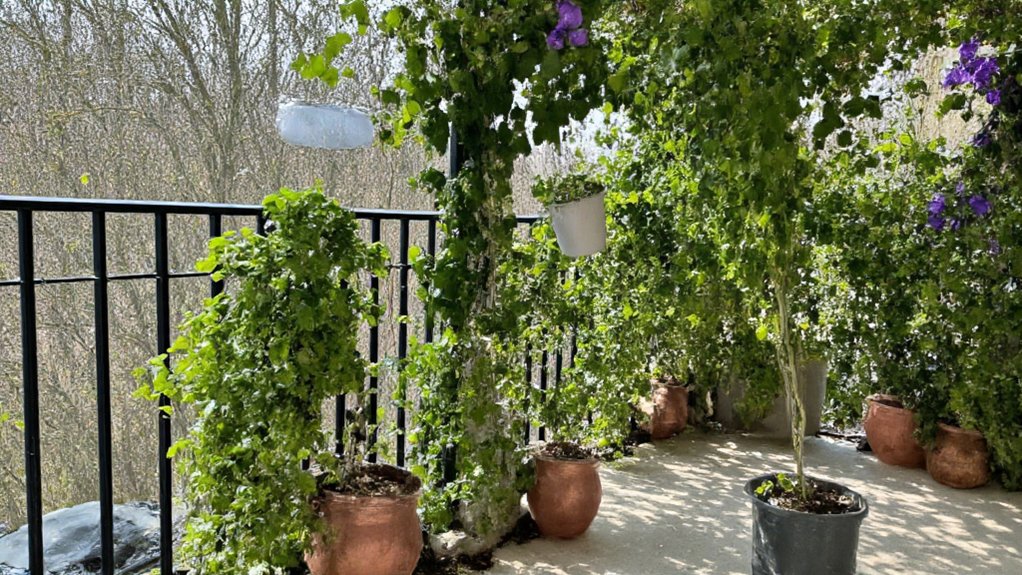
Incorporating trailing vines into balcony flower displays can add a dramatic and lush effect, transforming a simple space into a cascading garden. Vines like ivy, pothos, or flowering varieties such as morning glory and clematis can drape over railings or hang from pots, creating a waterfall of greenery and color. These plants not only enhance vertical interest but also soften the harsh lines of balcony structures, making the area feel more inviting and natural.
To maximize the impact, place trailing vines in hanging baskets or elevated planters near the edges of the balcony, allowing them to spill over and draw the eye downward. Pair them with upright flowers or foliage in the same container for a balanced look, ensuring the vines have room to grow without overwhelming other plants. This approach adds depth and movement to your display, turning your balcony into a dynamic, living work of art.
Mix Textures With Foliage and Blooms
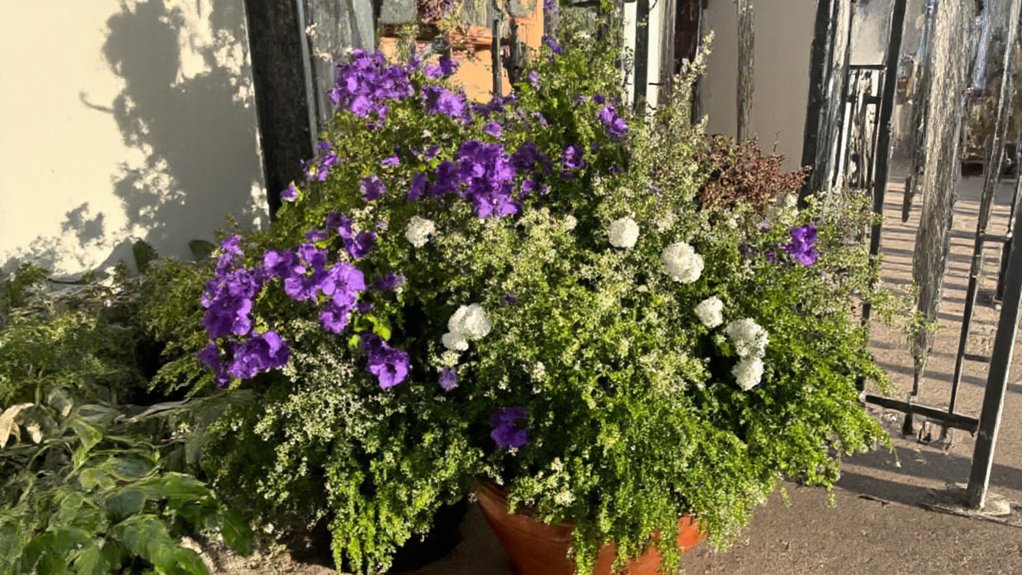
Mixing textures with foliage and blooms is a key strategy for creating visually enchanting balcony flower displays. By combining plants with different leaf shapes, sizes, and surface qualities—such as smooth, fuzzy, or serrated—you can add depth and interest to your arrangement. For instance, pairing the soft, feathery leaves of ferns with the bold, glossy foliage of a peace lily creates a striking contrast that draws the eye.
Incorporating a variety of blooms further enhances this effect, as flowers bring their own unique textures through petal shapes and arrangements. Think of the delicate, layered petals of a rose alongside the spiky, structural blooms of a salvia. This interplay of textures not only elevates the aesthetic appeal of your balcony but also guarantees a dynamic display that remains engaging throughout the seasons.
Add Vertical Gardens for Space Efficiency

Adding vertical gardens to a balcony flower display is an excellent way to maximize limited space while creating a stunning visual impact. Vertical gardens utilize wall-mounted planters, trellises, or hanging systems to grow plants upwards rather than outwards, making them ideal for small balconies. This approach allows you to incorporate a variety of flowers, herbs, or even small vegetables without cluttering the floor space, leaving room for seating or other decor.
To implement a vertical garden, consider installing wall planters or using stackable pots that can be secured to railings or hung from hooks. Choose lightweight materials to avoid overloading the balcony structure, and opt for plants that thrive in vertical conditions, such as trailing vines, ferns, or succulents. Assure proper drainage and watering systems, like drip irrigation, to maintain plant health and prevent mess. This space-efficient solution not only enhances the aesthetic appeal of your balcony but also transforms it into a lush, green oasis.
Use Statement Flowers as Focal Points
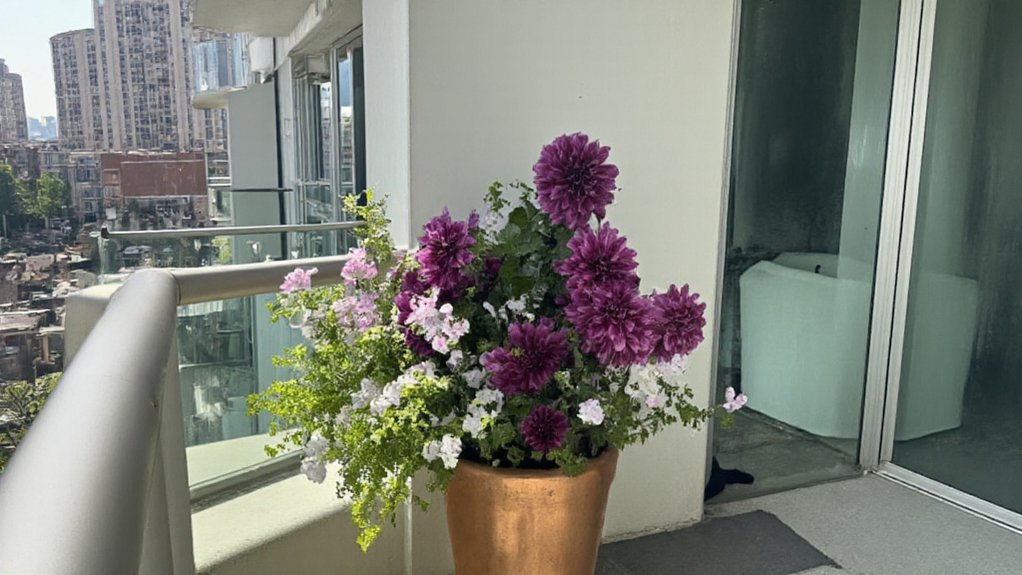
Statement flowers are bold, eye-catching blooms that serve as the centerpiece of your balcony flower display. These flowers, such as large sunflowers, vibrant dahlias, or striking lilies, draw attention and create a focal point that anchors the entire arrangement. By strategically placing a statement flower in the center or at a prominent spot in your container or hanging basket, you can establish a visual hierarchy that guides the viewer’s eye.
Choosing a statement flower with a contrasting color or unique texture compared to the surrounding plants enhances its impact. Pairing it with complementary filler flowers or greenery can further highlight its beauty, ensuring the display feels balanced and intentional. This approach not only adds drama to your balcony but also simplifies the design process by giving you a clear starting point for building the rest of the arrangement.
Integrate Ambient Lighting for Evening Charm
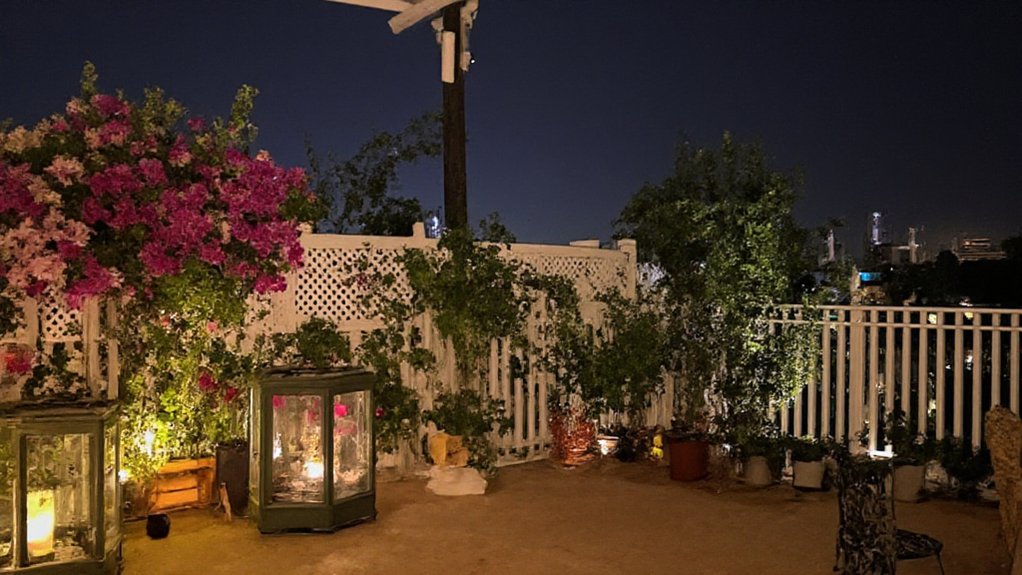
Integrating ambient lighting into your balcony flower displays can transform the space into a magical retreat during the evening hours. Soft, warm lights can highlight the vibrant colors and textures of your flowers, creating a cozy and inviting atmosphere. String lights, solar-powered lanterns, or LED candles can be strategically placed among the plants or along the balcony railing to add a subtle glow without overpowering the natural beauty of the floral arrangements.
Consider using weather-resistant lighting options to guarantee durability against outdoor elements. Positioning lights at varying heights, such as hanging from above or nestled within planters, can create depth and enhance the visual appeal of your display. This thoughtful addition not only extends the enjoyment of your balcony garden into the night but also adds an element of charm and sophistication to your outdoor space.
Select Seasonal Varieties for Year-Round Beauty
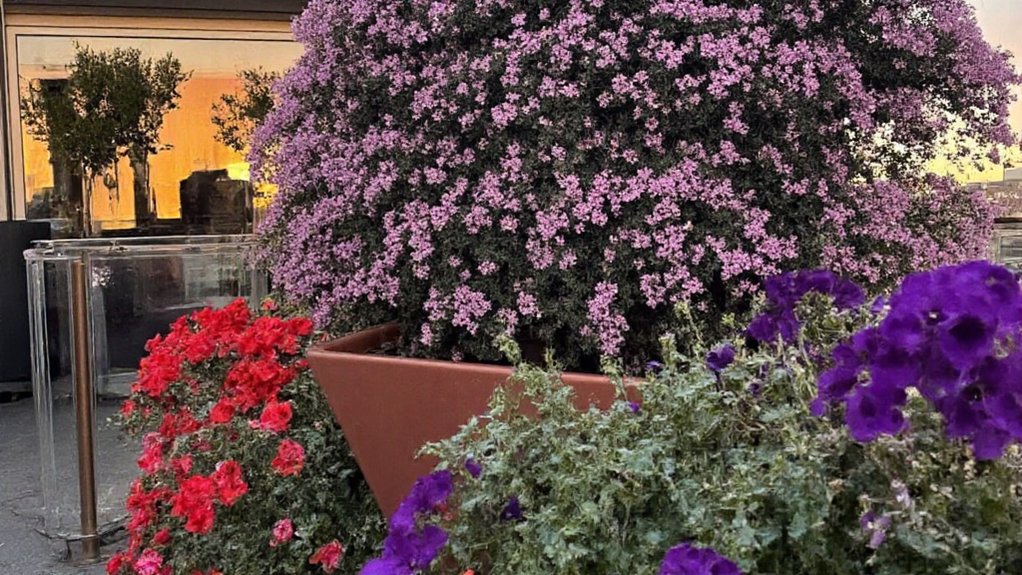
Selecting seasonal varieties is key to maintaining a vibrant balcony flower display throughout the year. By choosing plants that thrive in specific seasons, you can guarantee continuous color and texture, even as the weather changes. For spring, consider tulips and daffodils, which bring bright, cheerful blooms. In summer, opt for heat-loving flowers like petunias and geraniums that flourish under the sun.
For fall, chrysanthemums and pansies offer rich tones and resilience to cooler temperatures, while winter calls for hardy options like cyclamen or ornamental kale that can withstand frost. Rotating seasonal varieties not only keeps your balcony looking fresh but also aligns with nature’s cycles, making care and maintenance easier as the plants are naturally suited to the current conditions.
Create Symmetry for a Balanced Design
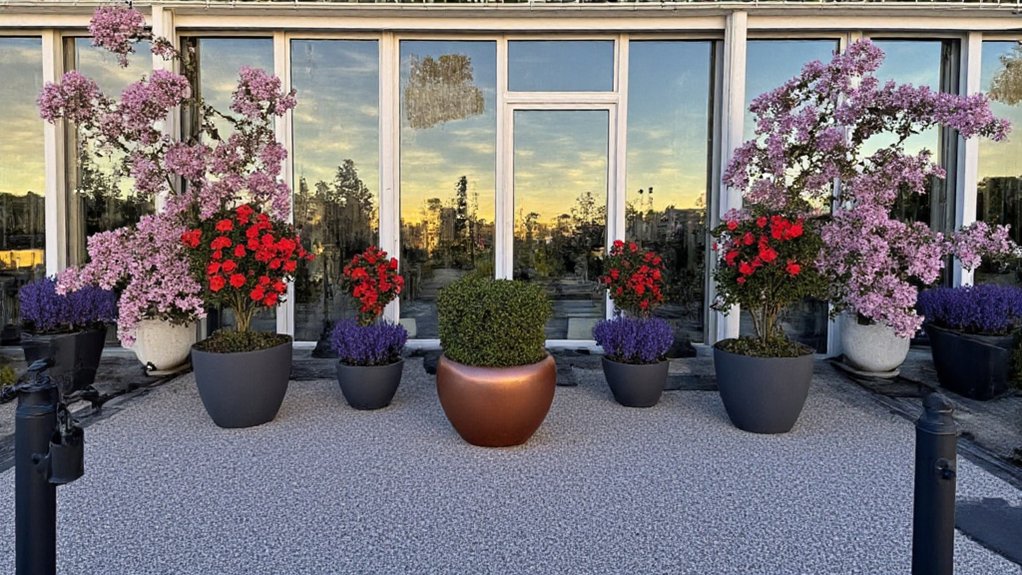
Creating symmetry in balcony flower displays is a key principle for achieving a balanced and visually appealing design. Symmetry involves arranging flowers, pots, and other elements in a mirrored or evenly distributed manner on either side of a central point, such as the balcony railing or a focal feature. This approach creates a sense of order and harmony, making the space feel organized and intentional, even in smaller areas.
To achieve symmetry, consider using matching containers or plants of similar height, color, or texture on both sides of the balcony. For example, place identical flowering plants like geraniums or petunias in matching pots at each end of the railing, or alternate complementary colors in a consistent pattern. This technique not only enhances the aesthetic appeal but also draws the eye evenly across the space, making the balcony feel cohesive and well-designed.
